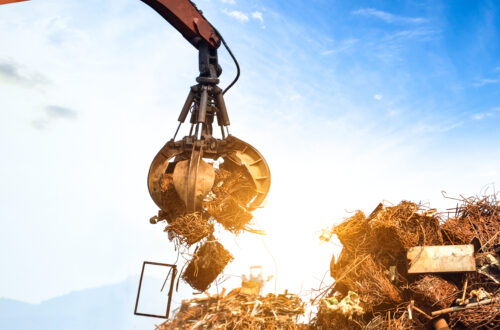
Scrap Yard Software Trends 2025: How Digital Tools Are Transforming Recycling
Scrap yard software trends are no longer just about fancy add-ons, they’ve become the backbone of modern recycling operations. With metal prices shifting daily, compliance rules getting tighter, and labor harder to come by, running a yard on manual systems just doesn’t cut it anymore.
In 2025, the message is loud and clear. Digital tools aren’t luxury upgrades, they’re profit protectors and problem solvers. From cloud-based platforms that keep teams connected anywhere, to mobile ticketing that speeds up transactions, and automation powered by AI that streamlines workflow, technology is redefining how yards stay ahead of the game.
Throw in real-time inventory tracking and built-in compliance safeguards, and the case for going digital has never been stronger. In this article, we’ll unpack the key scrap yard software trends shaping the industry and how they can boost your bottom line.
Top Scrap Yard Software Trends Shaping Recycling in 2025
Before we dive into the top five trends, it’s clear that the recycling world is moving full speed toward digital transformation. Scrap yard software is now at the heart of that shift, helping recyclers streamline operations, improve accuracy, and make smarter business decisions. These emerging trends highlight how technology is reshaping the way scrap yards work, compete, and grow in 2025.
Trend #1: Cloud-first Systems Make Scaling Realistic
For scrap yards, the days of juggling spreadsheets and siloed desktop programs are numbered. Cloud-first scrap yard software takes the headache out of data islands by syncing everything across sites in real time.
That means whether you’re checking inventory, reconciling payments, or pulling compliance reports, the same data is available to every yard and every employee without duplicate entries or chasing updates over the phone.
Picture this: you open a second location. Traditionally, that might mean doubling your admin staff just to keep tickets, scale data, and reports aligned.
With a cloud-based system, the new yard simply plugs into the same platform. Scale tickets, payments, and vendor records flow automatically, so you expand without piling on back-office chaos.
Growth is one reason cloud matters, but resilience is another. Automatic backups, guaranteed uptime, and remote access mean you’re protected against server crashes, natural disasters, or even a laptop going down. In short, your operation keeps running smoothly, no matter what.
Trend #2: Mobile & digital ticketing speed up throughput
If you’ve ever stood at the scale house waiting for a handwritten ticket, you know how slow and error-prone the old system can be. Manual ticketing often meant messy handwriting, mismatched weights, and long delays while staff keyed everything into the back office later. Today, mobile apps and direct scale integrations are flipping that experience on its head.
With digital ticketing, drivers roll up, get weighed, and their ticket is instantly generated in the system, there are no scribbled slips, no double entry. Payments process faster, disputes drop, and trucks spend less time idling at the gate.
One mid-sized yard that switched to a mobile-first system reported cutting average gate times by nearly a third, simply because the ticket flow became seamless.
The payoff goes beyond speed. By having every ticket logged digitally, compliance records stay clean, reports generate instantly, and both vendors and customers get more transparency. It’s a win-win for efficiency and trust.
Trend #3: Real-time Inventory & Pricing From Guessing To Strategy
In scrap yards running on clipboards or lagging spreadsheets, inventory is often a guessing game. Material piles up, prices shift overnight, and decisions hinge on best guesses rather than hard data. Real-time inventory tracking flips that script.
Every load weighed at the scale automatically updates the system, so you know exactly what’s on the ground, what’s committed, and what’s ready to move. Pair that with live pricing feeds, and you’ve got a powerful strategy tool.
Instead of selling too early or overbuying at the wrong time, you can match sales with peak market conditions and avoid tying up cash in excess material. Even shrinking mysterious losses that eat into margins becomes easier to spot when every pound is tracked in real time.
The real magic happens when these systems integrate with procurement and pricing signals. Imagine buying smarter because your software knows not just what you have, but what the market wants next. That’s not just efficiency’s competitive advantage.
Trend #4: Compliance, Audit Trails, And Security Are Now Survival Tools
Paper trails don’t cut it anymore. With tighter regulations and rising scrutiny, scrap yards need records that are clear, reliable, and easy to produce on demand. That’s where digital tools step in.
Capturing customer IDs, time-stamping tickets, and snapping photos of each load creates a bulletproof audit trail. If a regulator comes knocking or a vendor questions a transaction, you’ve got hard evidence ready to go.
The real win is in automated reporting. Instead of staff wasting hours piecing together paperwork for an audit, the system can generate everything in minutes. That means less stress, lower risk, and more time spent actually running the yard instead of chasing files.
It’s no surprise that review sites like Capterra highlight compliance features as one of the biggest factors buyers look for in recycling software. In today’s environment, tools that protect your operation aren’t just “nice extras.” They’re what keep your business safe and running smoothly.
Trend #5: Automation, AI, and hardware Integration (Scale, IoT, Sorting Tech)
The scrap yard of tomorrow is starting to take shape today, and it’s powered by automation, AI, and smarter hardware. From IoT-connected scales that feed data directly into your system, to automated ticket generation that eliminates manual entry, the technology already reduces errors and cuts down on repetitive labor.
Add photo verification at intake, and you’ve got a cleaner, faster process with fewer disputes. The horizon looks even more exciting. AI-driven sorting tech is beginning to surface, especially in e-waste recycling, where precision matters.
Instead of relying solely on manual pickers, machine learning tools can identify and separate valuable materials faster and with fewer mistakes. It’s still early days, but the momentum is real. Vendors like Clifton Metals are already experimenting with robotics and AI-powered solutions to stay ahead of the curve.
Why does it matter? Because automation isn’t just about efficiency; it’s about staying competitive in a market where labor is tight and compliance is unforgiving.
The yards that adopt these tools first will likely set the pace for everyone else. Emerging or not, automation and AI are quickly moving from “nice idea” to “industry standard.”
How to pick the right solution?

Choosing the right scrap yard software can feel overwhelming, but a simple checklist helps narrow it down. Start with ease of use. If your crew won’t adopt it, it won’t deliver value.
Next, look for cloud and mobile support, so your team can access data from anywhere. Scale integration is a must-have to cut down errors, while strong reporting and compliance features keep regulators satisfied.
Don’t forget to review the pricing model (subscription vs. license) and the quality of onboarding and support because even the best tool fails without a good setup and training.
When it’s time to roll out, take it slow. Run a pilot on one shift before going yard-wide, back up your old records, and designate a “power user” who can help train and troubleshoot for the team. This way, adoption feels smooth instead of overwhelming.
And here’s a quick ROI tip: calculate the impact of shorter gate times. Use a simple formula
Reduced dwell time (minutes) × average loads per day = total hours saved monthly.
Multiply that by your labor or equipment cost per hour, and the monthly gains become crystal clear.
The right system doesn’t just organize your yard, it pays for itself.
Conclusion
2025 is shaping up to be the year scrap yards either embrace digital transformation or risk falling behind. Cloud systems, mobile ticketing, automation, real-time inventory, and compliance tools aren’t just industry buzzwords; they’re what separates thriving yards from struggling ones.
The opportunity is clear: better efficiency, stronger margins, and fewer compliance headaches. See real savings. Book a quick demo at BuyScrapSoftware.com and get a custom ROI estimate for your yard.



